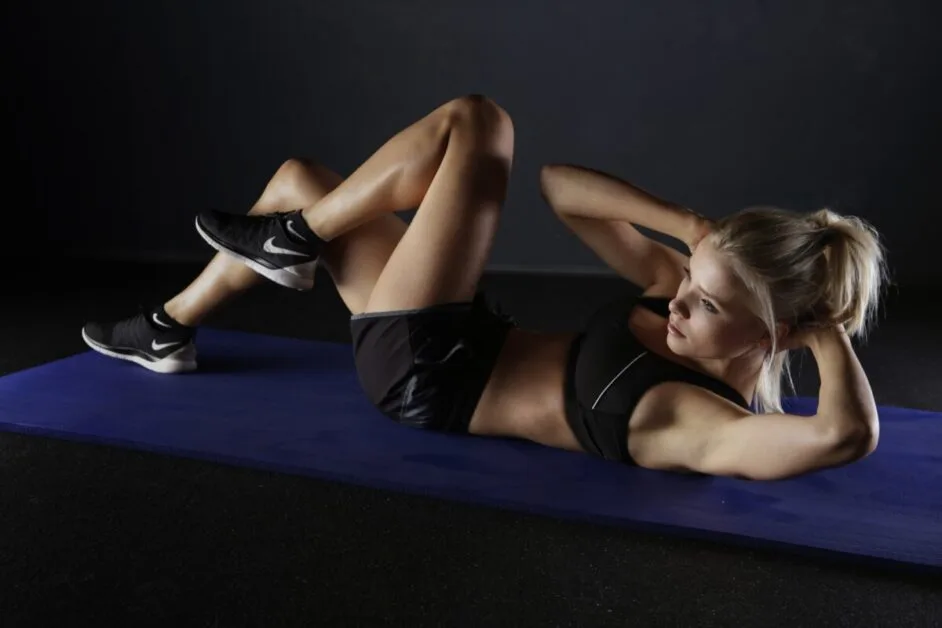Some of the links in this post are affiliate links. This means if you click on the link and purchase the item, we will receive an affiliate commission from the vendor at no extra cost to you. These business relationships allow us to keep bringing you great EatMoveHack content. All opinions remain our own.
Sore or tense muscles are a common problem after exercising. While this is normal, they can be uncomfortable and can take up to two days to fully recover. This article will explore some ways you can quickly (and safely) speed up your muscle recovery after exercise.
What Makes Muscles Sore After Working Out?
 There are a few different reasons why your muscles feel sore after you work out. Most of the time, sore muscles are the result of stretching them out of their normal limits. When you exercise, it creates small tears in the muscle fibers. Over time, these tears will build your muscles to be larger and stronger, but at the time, will cause slight discomfort.
There are a few different reasons why your muscles feel sore after you work out. Most of the time, sore muscles are the result of stretching them out of their normal limits. When you exercise, it creates small tears in the muscle fibers. Over time, these tears will build your muscles to be larger and stronger, but at the time, will cause slight discomfort.
This is often referred to as DOMS (Delayed Onset Muscle Soreness). DOMS occurs a few hours after workouts and lasts about 72 hours afterward. While this isn’t a cause for concern, if the muscle soreness lasts for more than five days, you probably want to get it checked out.
8 Ways to Speed Up Muscle Recovery After Working Out
1 – Get Enough Sleep
One of the best ways to help speed up your muscle recovery is to rest your body. As you sleep, your body will release special hormones, like the human growth hormone, to help restore the muscle fibers and reduce inflammation.
Numerous studies have also shown that adequate sleep has a significant effect on how well your muscles recover and even how much muscle mass your body produces. For instance, in one study, participants who slept for around eight hours had 40% more muscle mass than those who only slept for five.
Besides this, sleeping can boost your mind and make you more energetic and ready to exercise again.
2 – Drink Plenty of Water
Water is crucial in muscle recovery. By drinking water, it will carry oxygen throughout your body. This invigorates your muscles and helps to stop inflammation caused by workouts.
In addition to this, drinking enough water when working out keeps your body hydrated. When your body has enough fluid flowing through it, it cushions your muscles to prevent serious injuries. It also gives energy to them so you can exercise longer.
 3 – Consume Tart Cherry Juice
3 – Consume Tart Cherry Juice
Tart cherry juice has been shown to help ease sore and stiff muscles. While it has a very sour taste, tart cherry juice is packed with antioxidants, including anthocyanins. Anthocyanins have anti-inflammatory properties and can prevent oxidative damage caused by exercise.
One study found that runners who drank tart cherry juice at least one week before a major running event saw less muscle pain than when they didn’t.
Most experts recommend drinking about 8-12 ounces of tart cherry juice per day for the best results. However, it’s important to not overdo it. If you drink too much tart cherry juice, it could cause diarrhea. Because of this, go slow and only drink the recommended amount per day.
Make sure that you drink tart cherry juice, not regular cherry juice. Regular cherry juice is usually filled with sugar and doesn’t contain the same amount of antioxidants as tart cherry juice. Due to this, it won’t be as effective.
4 – Use a Foam Roller
A foam roller is a cylindrical tube that you roll your body over to help reduce muscle soreness and tension. It works as a myofascial release massage which works to stop tight muscles and increase their range of motion.
There have been quite a few studies that showed a foam roller is effective at treating DOMS. By rolling your body over it, it prevents muscle fatigue and even builds-up your muscles.
Using a foam roller is pretty easy. All you need to do is place it over the area with muscle soreness and roll your body over it.
There are a few different types you’ll find available. These include traditional foam rollers, those with grooves in them (to better reach muscles), and even heated ones.
5 – Eat Anti-Inflammatory and Protein-High Food
Your diet can play a major role in how quickly your muscles recover after exercising. Inflammation can be very irritating and could make you feel weak. By consuming plenty of anti-inflammatory items, it can prevent these side effects.
Some of the top anti-inflammatory options to eat include:
- Tomatoes
- Salmon
- Almonds
- Tuna
- Blueberries
- Cherries
- Turmeric
- Ginger
In addition to anti-inflammatory food, it’s important to eat food high in protein. This macronutrient is crucial to help muscle fibers recover and build your muscles up. In other words, protein can increase your muscle mass while preventing serious muscle soreness.
If you’re searching for food high in protein, some to try are:
- Eggs
- Lentils
- Pumpkin seeds
- Greek yogurt
- Chickpeas
- Tofu
- Beef
- Chicken
You could also make your own protein shakes to enjoy after your workouts. To create them, simply blend some fruit and protein powder together.
Here is an article you should check out –Muscle Recovery Food To Get You Back On Track.
6 – Try Chiropractic Adjustments
Chiropractic adjustments can be very helpful at not only relieving sore or aching muscles but preparing them for future workouts. A chiropractor will do various adjustments, like direct thrust or muscle energy ones, to remove lactic acid around your muscles and increase oxygen by boosting your red blood cells. This will create energy for your muscles so they feel refreshed and energetic.
Many chiropractors also offer massage therapy. A massage can be very helpful at relieving sore muscles because it reduces inflammations and speeds up their recovery. Some types they might use on your body include shiatsu, hot stone, and reflexology.
But how often should you get chiropractic adjustments for muscle recovery? Most of the time, around twice a month is adequate.
7 – Apply Ice
Ice packs work to soothe muscles because they serve as a local anesthetic. Ice will block pain signals being sent to your brain which can reduce the amount of soreness you feel. Place ice on the sore muscles as soon as you can for the best results. Ideally, leave an ice pack on them for about 30 minutes at a time and repeat the process two times per day.
8 – Use Stretching
Stretching helps release tension and can prevent your muscles from contracting and getting stiff. It will increase your flexibility which can protect your body from potential injuries.
You can do simple stretches like knee-to-chest, standing hamstring, or chest and shoulder. Stretching can also be done by doing simple exercises, like walking or swimming.
Keep in mind that these won’t fully heal muscle soreness. Rather, they will help to stretch the muscles to prevent them from becoming further tense. Stretching will also improve blood flow so that plenty of oxygen gets sent to your muscles.
Muscle soreness is a common issue after working out. While not a serious concern, it can cause slight discomfort. By keeping these tips in mind, you can be sure that you’ll be able to not only speed up your muscle recovery but protect your body from injuries.
Here is an article on biohacking your way to muscle recovery –How to Biohack Muscle Recovery.
Also, one key way to improve recovery is to avoid injuries or exercise mistakes. You can find more here on this topic, which is very important.
Conclusion:
If you enjoyed this article please check out our homepage so you can learn about more great tips that can help you live your best life – click here!
References
https://www.ncbi.nlm.nih.gov/pmc/articles/PMC2874510/
Author Bio
Dr. Brent Wells, D.C. founded Better Health Chiropractic & Physical Rehab and has been a chiropractor for over 20 years. His practice has received great reviews and top ratings from thousands of patients in Juneau from different health problems using services including chiropractic care, physical rehab therapy, and massage therapy designed to help patients receive long-lasting relief.
He is a proud member of the American Chiropractic Association and the American Academy of Spine Physicians. And he continues his education to remain active and updated in all studies related to neurology, physical rehab, biomechanics, spine conditions, brain injury trauma, and more.

